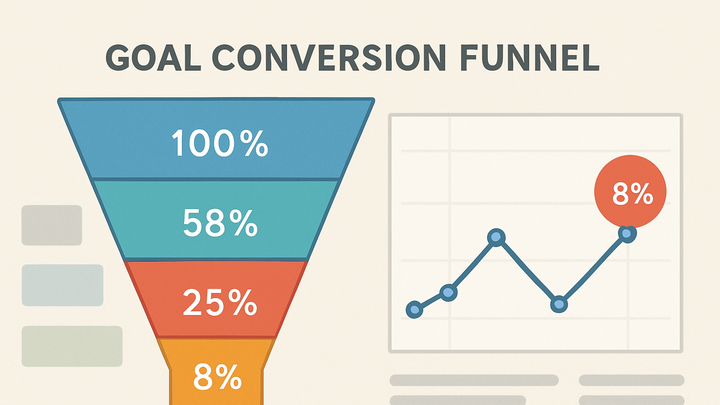Published on 2025-06-22T03:27:40Z
What is Goal Conversion Rate? Examples for Goal Conversion Rate.
Goal Conversion Rate is the percentage of visits to your website or app that complete a specific goal action, such as a purchase, sign-up, or download. It helps you gauge the effectiveness of your marketing efforts and user experience in turning visitors into customers or leads. A high Goal Conversion Rate indicates that your site is successfully persuading visitors to take the desired action, while a low rate points to areas for optimization. In analytics, tracking and improving this metric is central to achieving business objectives and maximizing ROI. Platforms like PlainSignal and GA4 provide built-in tools to define, track, and report on goal conversions accurately.
Goal conversion rate
The proportion of users who complete a defined goal, essential for measuring marketing and UX success.
Why Goal Conversion Rate Matters
Goal Conversion Rate reveals how effectively your website or app persuades visitors to take key actions. It bridges the gap between traffic metrics and real business outcomes, offering actionable insights into user behavior, campaign performance, and revenue generation.
-
Performance measurement
Measures the success of your marketing channels and campaigns by showing which sources drive valuable actions.
-
User experience optimization
Highlights friction points in your user journey by pinpointing drop-off stages before goal completion.
How to Calculate Goal Conversion Rate
Calculating Goal Conversion Rate is straightforward: divide the number of completed goal actions by the total number of visits (or sessions), then multiply by 100. This yields the percentage of sessions that resulted in a conversion.
-
Basic formula
Goal Conversion Rate = (Number of Goal Completions / Total Sessions) × 100
-
Example calculation
If you have 50 newsletter sign-ups (goal completions) from 2,000 sessions, the conversion rate is (50 / 2000) × 100 = 2.5%.
Implementing Goal Tracking with PlainSignal and GA4
Both PlainSignal and GA4 allow you to define and track custom goals or events. Here’s how to set up goal conversion tracking in each platform:
-
Tracking with PlainSignal
Add the PlainSignal snippet to your site and define goals via the JavaScript API or dashboard:
<link rel="preconnect" href="//eu.plainsignal.com/" crossorigin /> <script defer data-do="yourwebsitedomain.com" data-id="0GQV1xmtzQQ" data-api="//eu.plainsignal.com" src="//cdn.plainsignal.com/plainsignal-min.js"></script>Then configure a goal in PlainSignal’s dashboard by specifying the event name and criteria for completion.
-
Tracking with GA4
In Google Analytics 4, use the gtag.js snippet to send events and mark them as conversions:
<!-- GA4 Global Site Tag --> <script async src="https://www.googletagmanager.com/gtag/js?id=G-XXXXXXXXXX"></script> <script> window.dataLayer = window.dataLayer || []; function gtag(){dataLayer.push(arguments);} gtag('js', new Date()); gtag('config', 'G-XXXXXXXXXX'); gtag('event', 'sign_up', { 'method': 'Newsletter' }); </script>Then, in the GA4 interface, mark the event name (e.g., ‘sign_up’) as a conversion.
Best Practices for Optimizing Conversion Rates
To improve your Goal Conversion Rate, implement data-driven optimizations and continuous testing across your marketing and UX strategies.
-
Define clear goals
Choose specific, measurable goals that align with business objectives, like purchases or form submissions.
-
Segment your audience
Analyze conversion rates by channel, device, or user segment to identify high-value groups and tailor experiences.
-
A/b testing
Experiment with page layouts, copy, and calls to action to determine which variations yield the highest conversions.
Common Pitfalls and How to Avoid Them
Be aware of frequent mistakes that can skew your conversion data or lead to misguided optimization efforts.
-
Tracking misconfiguration
Incorrect snippet placement or missing event parameters can result in underreported conversions. Always verify with real-time debug tools.
-
Ignoring micro-conversions
Focusing only on final conversions overlooks smaller actions (e.g., video views) that signal engagement and can optimize the funnel.
-
Overlooking attribution windows
Short conversion windows may miss delayed conversions from campaigns with longer purchase cycles. Adjust attribution settings accordingly.
